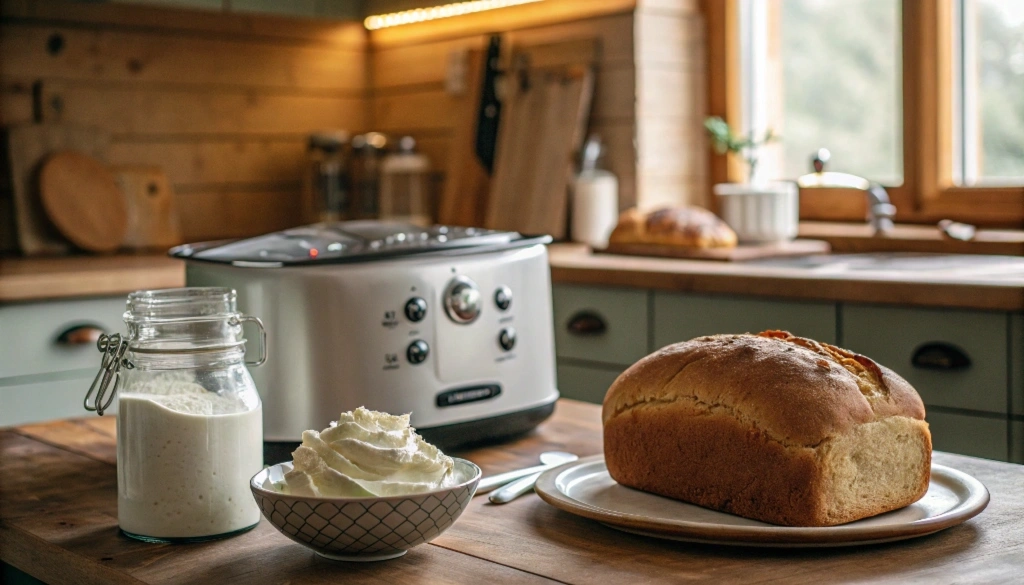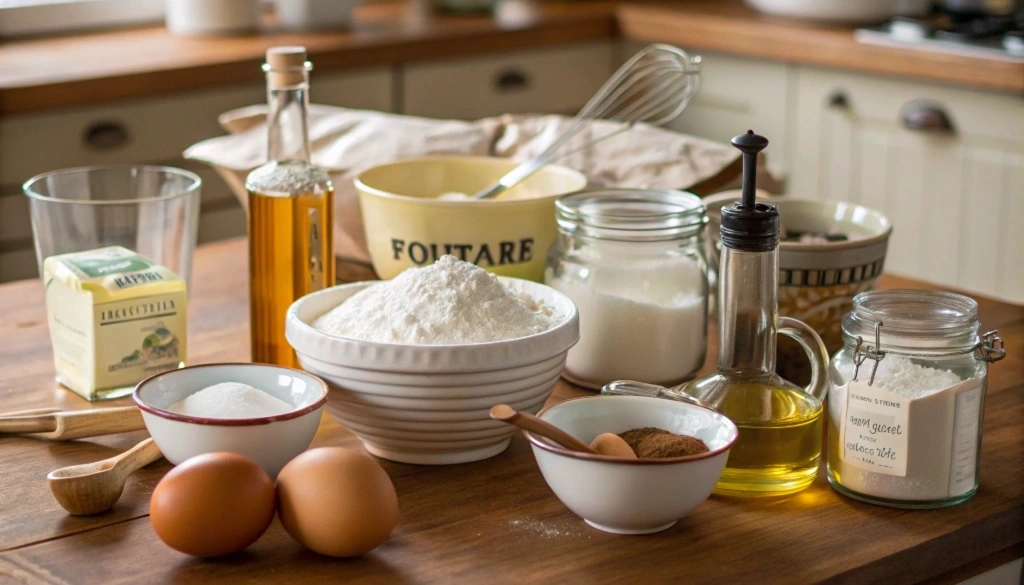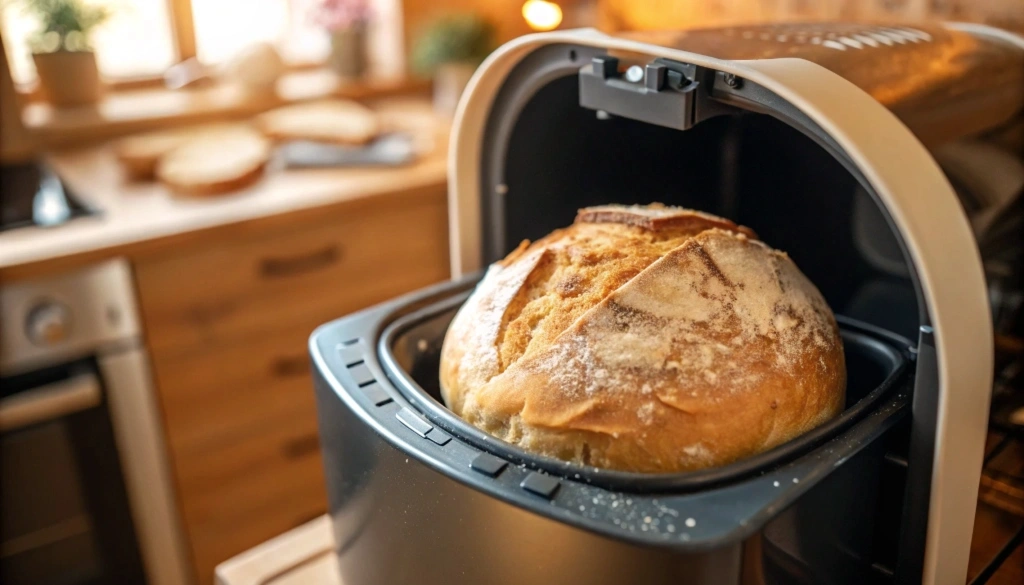The smell of fresh bread in your home brings back happy memories. Stottie cake is a special treat from North East England’s past. Today, I’ll show you how to make it easily with a bread machine.
Table of contents
Imagine coming home to a house smelling of baking. A homemade Stottie Cake recipe is waiting for you. This bread is dense and chewy, a tribute to those who baked it before us. With a bread machine, making this authentic Stottie Cake recipe is simple, using just flour and yeast.

This guide will help you make a simple stottie cake. You can enjoy homemade bread without hassle. Baking can be both easy and authentic.
National Stottie Cake Week celebrates local pride and flavors. Try making this bread to join in. Once you get the hang of it, you can try different fillings and flavors.
Visit Morsel Recipesfor more easy recipes and kitchen tips. Make your cooking journey stress-free.
Key Takeaways
- Stottie cakes originated in North East England and are known for their dense, chewy texture.
- Precise measurement of ingredients is crucial for perfect results when using a bread machine.
- Bake stottie cakes at 400°F (200°C) for 20-25 minutes until golden brown.
- Store in an airtight container at room temperature for up to 2 days or freeze for up to 3 months.
- Experiment with traditional fillings like ham and pease pudding, or modern twists like hummus and roasted vegetables.
The History and Origin of Stottie Cake
The Stottie Cake recipe history is deeply tied to North East England’s culture. This traditional bread, known as the Geordie stottie, comes from the industrial heartland. It shows the hard work and smart thinking of working-class families.
Stottie cakes were made from leftover dough, a smart move to save money. They are known for their large size, up to 30 centimeters (11.8 inches) in diameter. Their dense, chewy texture made them perfect for shipyard workers and miners.

Today, stottie cakes are lighter thanks to new baking methods. But, there’s a debate about the best texture. Some like the crusty, traditional stottie, while others prefer the softer, modern versions.
This beloved British regional bread was a mainstay in North East England homes. In the 1920s, you’d often see them cooling on windowsills. Filled with egg and bacon, they made for satisfying meals. Local bakers, like Greggs of Gosforth, keep the authentic recipe alive.
Learning about the Stottie Cake recipe’s origins gives us a glimpse into North East England’s culinary past. Making a traditional Stottie Cake recipe was more than just cooking; it was a way to connect with local traditions and community efforts.
Ingredients for Stottie Cake
The key ingredients for stottie cake are strong white bread flour, salt, sugar, and yeast. These are vital for the traditional chewy texture. The recipe uses 500g of strong plain white flour for a robust structure. You also need 2 tsp of salt, 50g of lard, 8g of fast-acting dried yeast, and 1 tablespoon of sugar to boost yeast activity.
Finally, mix 180ml of warm water and 150ml of milk. This creates a dough that’s easy to handle in bread machine recipes.

Main Ingredients
- 500g strong white bread flour
- 2 tsp salt
- 50g lard
- 8g fast-acting dried yeast
- 1 tablespoon sugar
- 180ml warm water
- 150ml milk
These simple bread ingredients are crucial for a true Stottie Cake. They make the bread hearty and full of flavor, just like the oversized bap it’s known for.
Optional Additions
You can add your own twist to the traditional Stottie Cake recipe. Try adding a sprinkle of white pepper for a unique flavor. You can also add butter or oil for extra softness and richness. These changes can make your Stottie Cake more personal while keeping its traditional charm.
| Ingredient | Purpose |
|---|---|
| White Bread Flour | Structure and chewiness |
| Salt | Flavor enhancement |
| Sugar | Yeast activation |
| Yeast | Fermentation |
| Lard | Richness |
| Water and Milk | Dough hydration |
With these main and optional ingredients for stottie cake, you’re ready to bake a bread full of history and flavor. It’s perfect for both traditional and modern meals.
Stottie Cake Recipe Bread Machine Instructions
Making a perfect Stottie Cake in a bread machine is both an art and a science. Follow these homemade stottie instructions to make the best stottie cake every time.
Measuring and Adding Ingredients
Measuring and adding ingredients with precision is key for the right consistency. Start with liquids, then add dry ingredients. This way, the dough mixes well.
- For a 1-pound loaf, use 2 to 2-⅔ cups of flour. For a 1 ½-pound loaf, use 3 to 3-¾ cups of flour. For a 2-pound loaf, use 4-5 cups of flour.
- Add roughly 3/8 cup of liquid per cup of flour.
- Substitute instant yeast using 1/4 teaspoon less than the active dry yeast specified.
- Incorporate 1/2 teaspoon of salt per cup of flour.
- Start with no more than 1/2 cup of extra ingredients for a 1-pound recipe until you get the hang of it.
Selecting the Right Bread Machine Settings
Choosing the right settings on your bread machine is key for kneading and rising. For this stottie cake baking guide, use the basic or white bread setting. This setting kneads the dough well, making it chewy yet soft.
Timing and Temperature Guidelines
Even though your bread machine mixes and rises the dough, the final baking step is crucial. It gives the stottie cake its unique texture and flavor.
- Once the bread machine finishes, move the dough to a preheated oven at 400°F.
- Bake the dough for 20-25 minutes to get that classic crusty outside and fluffy inside.
By following these bread machine baking steps, you can make a traditional stottie cake at home. It’s known for its thriftiness and unique taste.
Tips for Achieving the Perfect Texture
Getting the perfect stottie texture is about kneading, rising, and baking right. These steps are key to a stottie cake with a chewy inside and a crisp crust.
Kneading and Rising Techniques
The dough is the base of a great stottie cake. Kneading it well is crucial for the chewy texture. Use a bread machine on the basic cycle, adjust liquids, and knead for about an hour.
After kneading, shape the dough into a flat disc. Let it rise in a warm place for 30-45 minutes. This makes the dough light and airy, essential for the perfect stottie texture.
Baking Method for Ideal Crust
Baking is just as important for the perfect stottie texture. Traditional ovens give a unique crust. At home, preheat your oven to 400°F (200°C).
Bake the stottie cake for 15 minutes to get a crisp crust. Then, lower the heat and let it rest for 20-30 minutes. This keeps the inside soft and chewy.
By following these kneading and baking tips, you’ll get the perfect stottie texture every time. The stottie cake has a rich history in North East England. These steps are important for a true taste experience.
Common Mistakes to Avoid
Baking stottie cake can be tricky. Here are some bread making errors to watch out for. They’ll help you bake a great stottie cake every time.
Dough Consistency Issues
A big baking mistake to avoid is the wrong dough consistency. Getting the flour-to-water ratio right is key. Too much water makes the dough sticky, too little makes it dry.
Strive for a balanced mix for the perfect stottie texture.
Temperature Control Problems
Temperature control is another major error to avoid. Bread machine issues often come from wrong temperatures during proofing and baking. Ensure your proofing temperature is just right for the dough to rise well.
When baking your stottie cake, keep the oven temperature steady. 425°F is the best temperature.
Shaping and Handling Errors
Proper shaping is crucial to avoid common bread making errors. Handle the dough gently when shaping your stottie cake. Don’t press it too hard, as this can affect its rise and texture.
Remember, the stottie cake’s simple shape is what makes it authentic.
By following these tips, you can avoid baking mistakes and get that perfect stottie texture every time.
Serving Suggestions and Storage Tips
Stottie cake is a beloved British bread known for its soft texture. It’s versatile and can be enjoyed in many ways. From traditional fillings to modern twists, it brings a taste of Northeast England to your plate.
For a classic taste, try it with fresh ham and pease pudding or just butter. These simple ways to serve highlight its rich flavor and soft crumb. Slicing it fresh ensures the best taste and texture.
Pair it with hearty soups or use it as a sandwich base. This makes it incredibly versatile.
Storing stottie cake right keeps it fresh and flavorful. It’s best enjoyed on the day it’s baked. But, with the right storage, you can keep it fresh for longer.
Store it in an airtight container at room temperature for up to two days. For longer storage, freezing is a great option. Slice the bread before freezing, so you can thaw and reheat as needed.
| Storage Method | Duration |
|---|---|
| Airtight Container | Up to 2 days |
| Freezing Slices | 1 month |
Following these storage tips lets you enjoy stottie cake’s taste even days after baking. Whether you serve it fresh or store it, every bite is as delightful as the first. Always keep in mind the privacy policy for food handling to stay informed and safe.
Traditional and Modern Fillings for Stottie Cake
The stottie cake is loved for its flexibility. It goes well with both old and new fillings. This makes it a favorite in many places. You can choose from classic North East flavors or try something new.
Classic North East Combinations
Stottie cakes often have fillings that show their North East England roots. Here are some favorite pairings:
- Ham and Pease Pudding: A classic mix that’s both hearty and tasty.
- Bacon: A popular choice, also found in Lancashire cafes and homes.
- Chips: A nostalgic favorite in North West England’s fish and chip shops.
- Pasty: Bolton’s take on the stottie cake, filled with savory pasty.
- Pie Barm: A Wigan specialty, where a pie is wrapped in a stottie, known as a “pie barm” or “Wigan kebab.”
Modern Filling Ideas
Today’s stottie cakes offer a mix of global tastes and new ingredients. Here are some modern stottie recipes to try:
- Smoked Salmon and Cream Cheese: A sophisticated mix of smoked salmon and creamy cheese.
- Hummus and Roasted Vegetables: A vegetarian’s dream, with creamy hummus and roasted veggies.
- Gochujang Pumpkin Buns: A spicy and sweet mix that adds a unique twist.
- Falafel and Tzatziki: A Mediterranean-inspired filling with crispy falafel and cool tzatziki.
The stottie cake is a versatile dish, perfect for both traditional and modern tastes. Whether you prefer classic flavors or new creations, there’s a stottie recipe for everyone.
FAQs
What is a Stottie Cake?
A Stottie Cake is a thick, doughy bread from North East England. It’s great for sandwiches or with soups and stews.
Can I make a Stottie Cake using a bread machine?
Yes, you can make a Stottie Cake with a bread machine. It’s easier and makes consistent bread, perfect for home.
What ingredients do I need for a Stottie Cake?
For a Stottie Cake, you need flour, water, yeast, and salt. You can also add butter, sugar, or milk for extra flavor and texture.
How do I measure and add ingredients in a bread machine?
Use a kitchen scale or measuring cups for precise measurements. Add ingredients in the order the manufacturer suggests, starting with liquids.
What bread machine settings should I use for a Stottie Cake?
Use the dough setting for the bread machine. After the dough cycle, shape it into a round cake. Then bake it in the oven.
How can I ensure the perfect texture for my Stottie Cake?
Good kneading and rising are key. Let the dough rise well and knead evenly. Bake at high heat for a golden crust.
What are common mistakes to avoid when making Stottie Cake?
Measure ingredients accurately to avoid dough issues. Keep the baking temperature right and handle the dough gently to keep its shape and texture.
How should I store Stottie Cake to keep it fresh?
Store Stottie Cake in an airtight container at room temperature. For longer storage, freeze it. Wrap it tightly in plastic or foil before freezing.
What are some traditional and modern fillings for Stottie Cake?
Traditional fillings include ham and pease pudding or bacon and egg. Modern options are chicken and avocado or roasted vegetables with hummus, adding a creative twist.
Conclusion
Discover the rich culture and unique taste of North East England by baking Stottie cake in a bread machine. This recipe is easy to follow and brings you closer to British baking traditions. You’ll need simple ingredients like strong white bread flour, salt, and sugar.
Knowing how to avoid common mistakes and using the right techniques is key. Focus on kneading, proofing, and using quality flour. You can also add cheese or herbs to make it your own. Try different fillings like butter and jam or avocado and poached eggs.
Stottie cake is more than just a recipe; it connects you to North East England’s baking traditions. It’s perfect for any meal and can be stored to stay fresh. This summary shows how baking Stottie cake brings a piece of British history into your kitchen. It turns baking into a journey through England’s rich food heritage.

